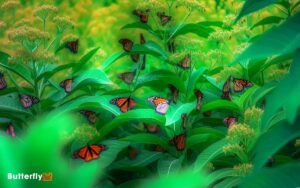How to Spot the Real-Life Blue Monarch Butterfly
Monarch butterfly chrysalides are renowned for their vibrant green color accented with gold speckling, measuring approximately 2.5 cm and weighing around 1.2 grams. In contrast, Queen butterfly chrysalides are more muted green with fewer gold spots, averaging 2.2 cm in length and 1.0 grams in weight.
Monarch chrysalides are denser at roughly 1.1 grams/cm³ compared to the Queen's 0.9 grams/cm³, which contributes to their structural integrity during metamorphosis. The Monarch's smooth and glossy exterior contrasts with the Queen's rough, matte surface.
Learn about their unique camouflage strategies and ecological roles by exploring further.
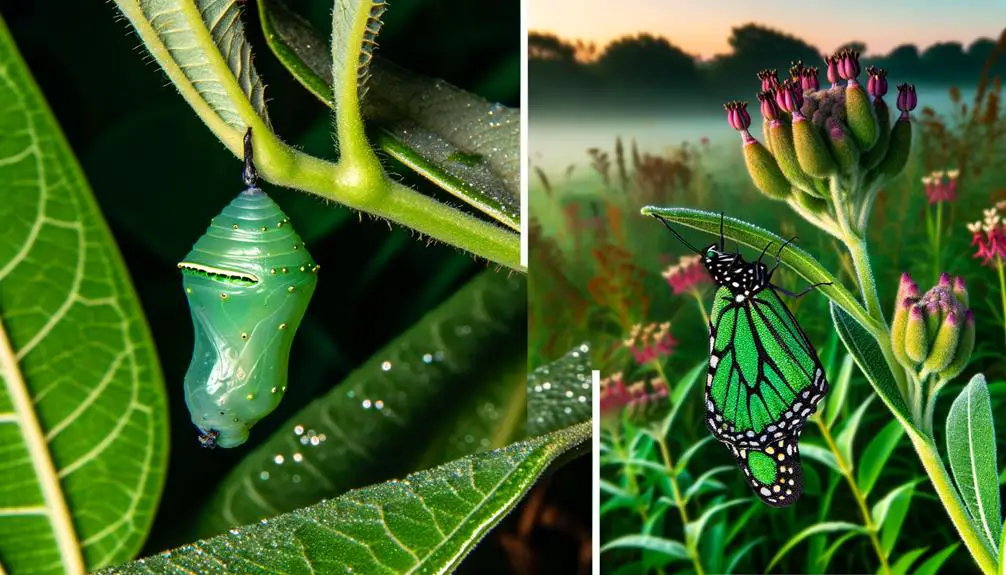
Key Takeaways
- Monarch chrysalis is vibrant green with gold speckling; Queen chrysalis is muted greenish-brown with fewer gold markings.
- Monarch chrysalis measures around 2.5 cm and weighs 1.2 grams; Queen chrysalis averages 2.2 cm and weighs 1.0 gram.
- Monarch pupal stage lasts 10-14 days; Queen chrysalis stage typically extends from 12-15 days.
- Monarch chrysalis has a smooth, glossy exterior; Queen chrysalis is rough and matte.
Metamorphosis Process
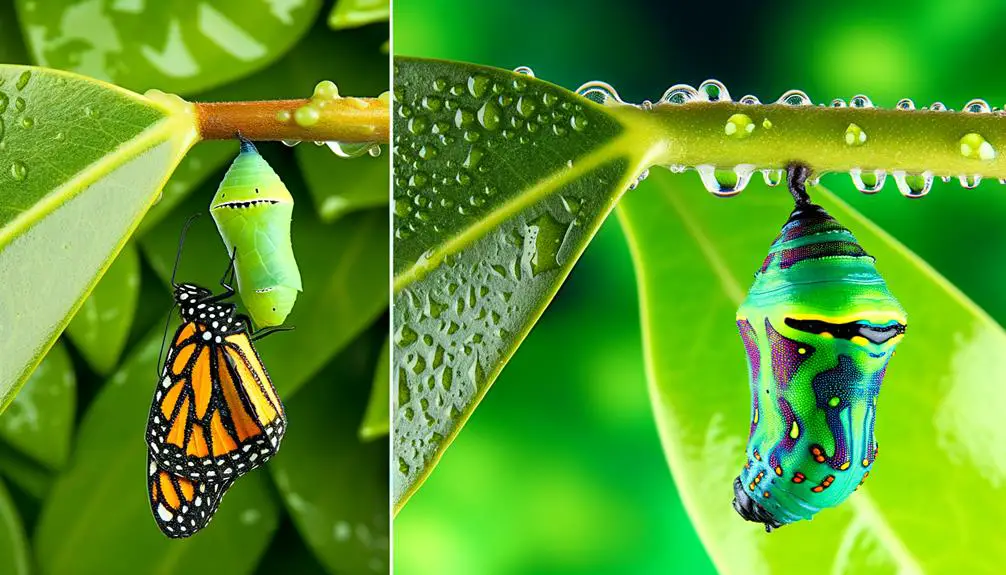
In examining the metamorphosis process, both the Queen butterfly (Danaus gilippus) and the Monarch butterfly (Danaus plexippus) exhibit a complete metamorphosis consisting of four distinct life stages: egg, larva, pupa, and adult.
The egg stage lasts approximately 3-5 days for both species. Following hatching, the larval stage, characterized by rapid growth and molting, spans about 10-14 days.
Shifting to the pupa stage, the chrysalis formation is a critical phase lasting 8-15 days, during which significant morphological changes occur.
Finally, the adult stage emerges, revealing fully developed wings and reproductive capabilities.
Detailed observations highlight that these stages are marked by specific physiological and biochemical transformations, essential for the butterflies' life cycles and survival.
Habitat Comparison
Queen and Monarch butterflies inhabit distinct yet occasionally overlapping ecosystems. Queens are primarily found in warmer regions such as the southern United States, Central America, and South America. In contrast, Monarchs are widely recognized for their extensive migratory patterns across North America.
The preferred habitats for Queens include arid and semi-arid environments where milkweed thrives. Monarchs, on the other hand, are often seen in temperate zones, relying on milkweed and nectar sources during migration.
Observations reveal the following:
- Queens thrive in tropical climates, exhibiting higher frequencies in regions with consistent warmth.
- Monarchs undertake remarkable migrations, traveling up to 3,000 miles.
- Queens are non-migratory, maintaining a year-round presence in their habitats.
- Monarchs face habitat fragmentation, impacting their migratory routes and breeding grounds.
Chrysalis Formation
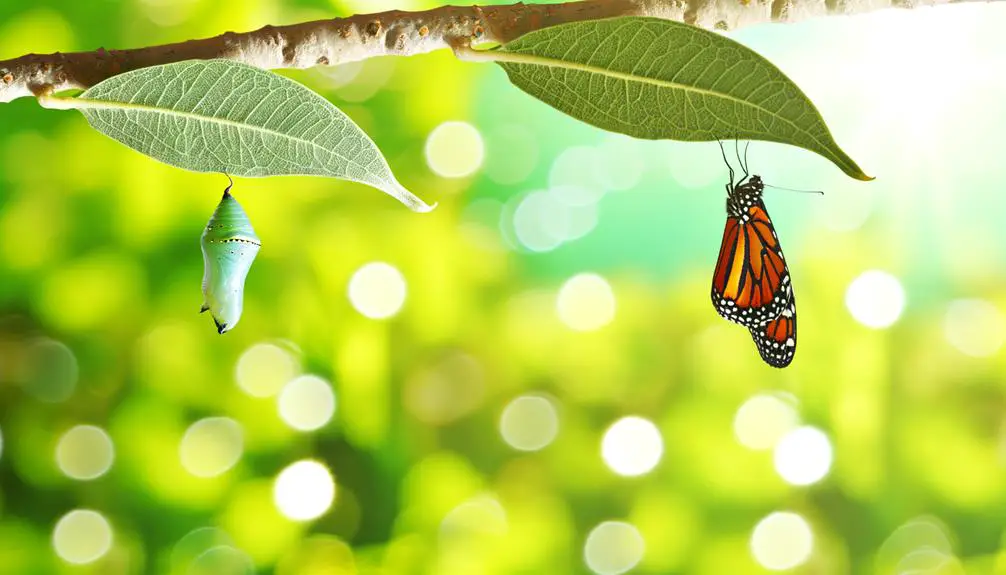
Examining the chrysalis formation of Queen and Monarch butterflies reveals key differences in their developmental stages, shedding light on the unique adaptations each species has evolved.
The Monarch (Danaus plexippus) chrysalis is characterized by its vibrant green hue and distinctive gold speckling, which serves as camouflage against predators.
In contrast, the Queen (Danaus gilippus) chrysalis exhibits a more muted green coloration, with fewer and less pronounced gold markings.
The time spent in the chrysalis also varies; Monarchs typically remain in their pupal stage for 10-14 days, while Queens may require slightly longer, averaging 12-16 days.
These variations in chrysalis formation underscore the evolutionary paths taken by each species to optimize survival and reproductive success.
Size Differences
When comparing the size differences between the Queen butterfly chrysalis and the Monarch chrysalis, notable disparities in length, weight, and density are observed.
The Monarch chrysalis typically measures around 2.5 cm in length, while the Queen chrysalis is slightly shorter, averaging 2.2 cm.
In addition, the Monarch chrysalis generally exhibits greater mass and density, with an average weight of 1.2 grams, compared to the Queen chrysalis, which averages 1.0 gram.
Chrysalis Length Comparison
With respect to size differences, the chrysalis of the Monarch butterfly (Danaus plexippus) typically measures around 2.5 centimeters in length, whereas the Queen butterfly (Danaus gilippus) chrysalis is slightly smaller, averaging approximately 2.2 centimeters.
This subtle variation in length can have profound implications on the developmental processes and overall physiology of these Lepidoptera species. Precise measurement is critical for entomologists aiming to understand these differences.
The following points highlight the importance of accurate chrysalis length measurements:
- Enhanced Developmental Insight: Understanding size differences aids in studying growth stages.
- Species Identification: Accurate measurements assist in distinguishing between species.
- Ecological Impact: Size variations can influence environmental adaptability.
- Conservation Efforts: Precise data support effective preservation strategies.
Weight and Density
The weight and density of the chrysalis play essential roles in the pupal development of both the Monarch and Queen butterflies, with Monarch chrysalides generally exhibiting a higher mass and density compared to their Queen counterparts.
Empirical measurements indicate that Monarch chrysalides typically weigh between 1.5 to 2.0 grams, while Queen chrysalides range from 1.2 to 1.6 grams. This discrepancy is attributed to the Monarch's larger size and more robust physiological requirements.
Additionally, the density of Monarch chrysalides is observed to be approximately 1.1 grams per cubic centimeter, surpassing the 0.9 grams per cubic centimeter of Queen chrysalides.
These differences in weight and density are critical for the developmental processes, ensuring structural integrity and metabolic efficiency during metamorphosis.
Coloration Traits
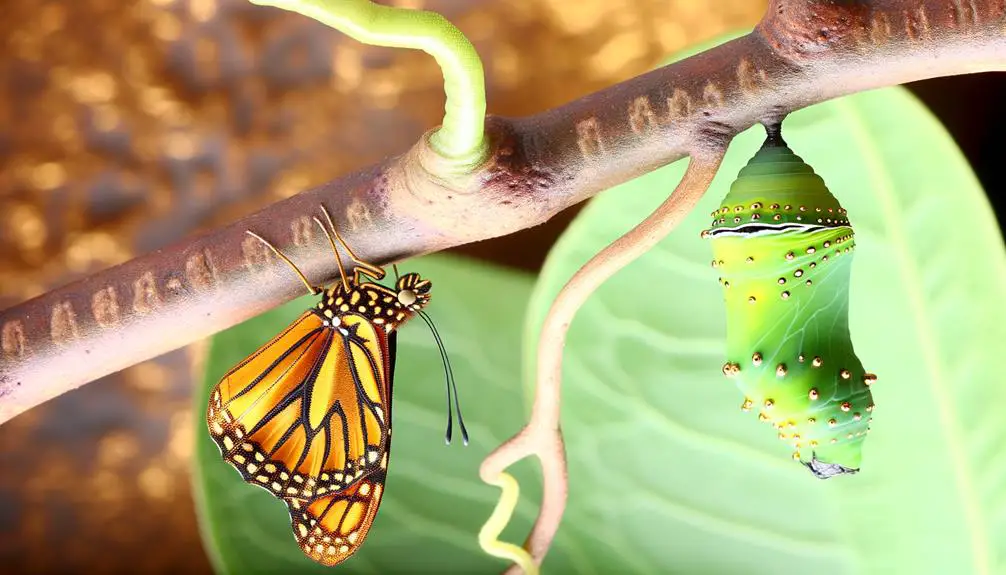
In examining the coloration traits of the Queen butterfly chrysalis versus the Monarch, significant differences are observed.
The Queen chrysalis typically exhibits a light green hue with subtle golden specks, while the Monarch chrysalis is more vibrant, showcasing a jade green coloration with conspicuous gold spots.
These distinctive markings and coloration patterns are critical for species identification and understanding their adaptive mechanisms in natural habitats.
Chrysalis Color Comparison
Chrysalis color differentiation between Queen and Monarch butterflies exhibits distinct pigmentation patterns, with Monarch chrysalises typically displaying a vibrant green hue adorned with metallic gold spots, whereas Queen chrysalises are characterized by a more muted greenish-brown tone.
This divergence in coloration is not merely aesthetic but may serve adaptive functions such as camouflage and predator deterrence. The Monarch's bright green chrysalis with its shimmering gold spots suggests a strategy to blend into lush, verdant environments, while the Queen's subdued coloration provides concealment in more earthy, natural surroundings.
- Monarch's gold spots: Evoke a sense of regality and wonder.
- Queen's earth tones: Reflect resilience and subtlety.
- Adaptive camouflage: Highlights evolutionary ingenuity.
- Pigmentation diversity: Celebrates nature's artistic palette.
Distinctive Markings Analysis
Distinctive pigment patterns and unique structural features in Queen and Monarch chrysalises provide critical insights into their respective evolutionary adaptations and ecological niches. The Monarch chrysalis exhibits a vibrant green coloration with gold-speckled bands, aiding in camouflage against predators. Conversely, the Queen chrysalis often displays a more muted, brownish hue with silver spots, blending seamlessly with dry foliage and creating an ideal hiding strategy.
| Trait | Monarch Chrysalis | Queen Chrysalis |
|---|---|---|
| Primary Color | Vibrant Green | Muted Brown |
| Secondary Markings | Gold-speckled Bands | Silver Spots |
| Camouflage Strategy | Blends with Green Foliage | Blends with Dry Foliage |
| Evolutionary Benefit | Enhanced Survival Against Predators | Ideal Concealment in Drier Environments |
This variation in coloration illustrates each species' unique approach to survival within their habitats.
Surface Texture
Characterized by its smooth and glossy exterior, the surface texture of the monarch butterfly chrysalis differs significantly from the comparatively rough and matte surface of the queen butterfly chrysalis. The distinct textures have pivotal implications for their development and environmental interactions.
- Smooth and Glossy: The monarch chrysalis exhibits a reflective sheen, indicating a highly ordered arrangement of chitin molecules, which enhances its structural integrity.
- Rough and Matte: The queen chrysalis features a textured surface, likely contributing to its camouflage capabilities and moisture retention.
- Microscopic Observation: Under magnification, the monarch chrysalis reveals a uniform surface with fewer particulate inclusions compared to the queen.
- Tactile Differences: Touching the monarch chrysalis feels sleek, while the queen chrysalis provides a more tactile, granular sensation.
This divergence underscores their unique evolutionary pathways.
Camouflage Strategies
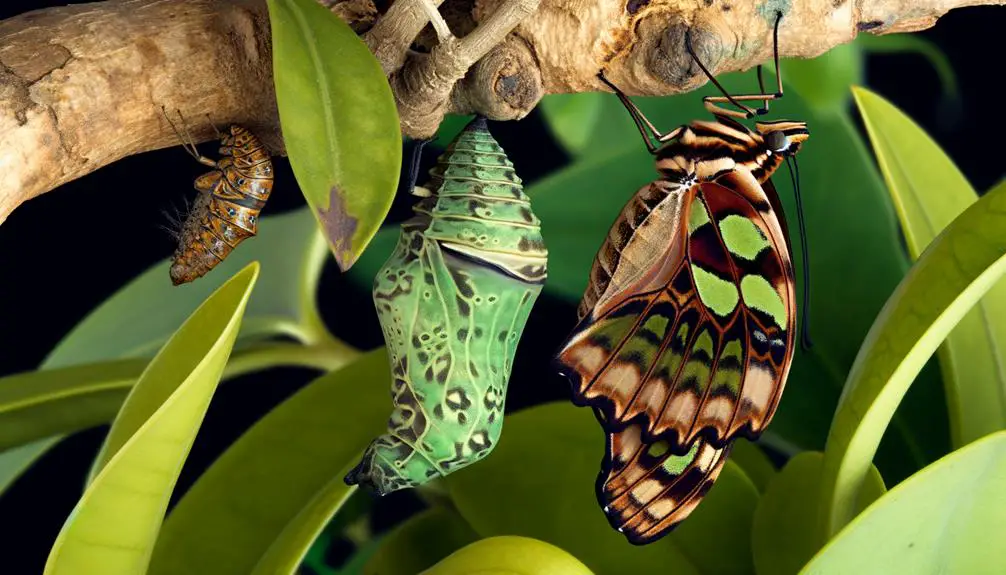
Both the monarch and queen butterfly chrysalides employ sophisticated camouflage strategies to enhance their survival rates in diverse environments.
Monarch chrysalides exhibit a jade green coloration complemented by metallic gold spots, which mimic dew droplets and blend seamlessly with foliage. This cryptic coloration provides protection from avian predators.
In contrast, queen butterfly chrysalides possess a brownish hue, mirroring the appearance of dried leaves or tree bark. This adaptive coloration aids in avoiding detection by predators such as birds and lizards.
Detailed observations reveal that the queen's chrysalides often position themselves within shaded areas, further enhancing their concealment.
Consequently, both species leverage their unique camouflage strategies to markedly reduce predation risk, showcasing evolutionary adaptations tailored to their specific ecological niches.
Duration of Development
The duration of development from chrysalis to adult butterfly exhibits notable differences between the Queen butterfly (Danaus gilippus) and the Monarch butterfly (Danaus plexippus).
Typically, the Monarch's pupal stage lasts approximately 10 to 14 days, whereas the Queen's chrysalis stage extends slightly longer, often ranging from 12 to 15 days.
Environmental factors such as temperature and humidity greatly influence these developmental timelines, with higher temperatures generally accelerating the process.
Development Time Comparison
A comparative analysis reveals that the developmental duration of the Queen butterfly chrysalis (Danaus gilippus) typically ranges from 7 to 10 days, whereas the Monarch butterfly chrysalis (Danaus plexippus) generally spans 10 to 14 days. This discrepancy in developmental time can be attributed to species-specific physiological processes and genetic differences.
Precise observations indicate that within these periods:
- Queen butterflies exhibit faster metamorphic changes, possibly due to their tropical habitat.
- Monarch butterflies have a protracted chrysalis stage, potentially enhancing their migratory robustness.
- Temperature sensitivity appears more pronounced in Monarchs, impacting their developmental rate.
- Eclosion timing synchronizes with ecological factors, influencing survival probabilities for both species.
Such differences underscore the intricate adaptability mechanisms inherent in each species, reflecting their evolutionary trajectories.
Environmental Impact Factors
Numerous environmental factors, such as ambient temperature, humidity, and photoperiod, critically influence the duration of chrysalis development in both Queen and Monarch butterflies.
Elevated temperatures accelerate metabolic rates, leading to shorter pupation periods, with Monarch chrysalides completing development in approximately 8-15 days at 25°C. Conversely, cooler temperatures prolong this phase.
Humidity levels also play an essential role; higher relative humidity guarantees proper eclosion while preventing desiccation.
Photoperiod, or the length of daylight exposure, indirectly affects hormonal cycles, thereby modulating developmental timing.
Research indicates that Queen butterflies exhibit similar responses, albeit with minor species-specific variations.
These factors collectively underscore the complex interplay between environmental conditions and developmental timelines, emphasizing the adaptability and resilience of these lepidopteran species.
Predation and Defense
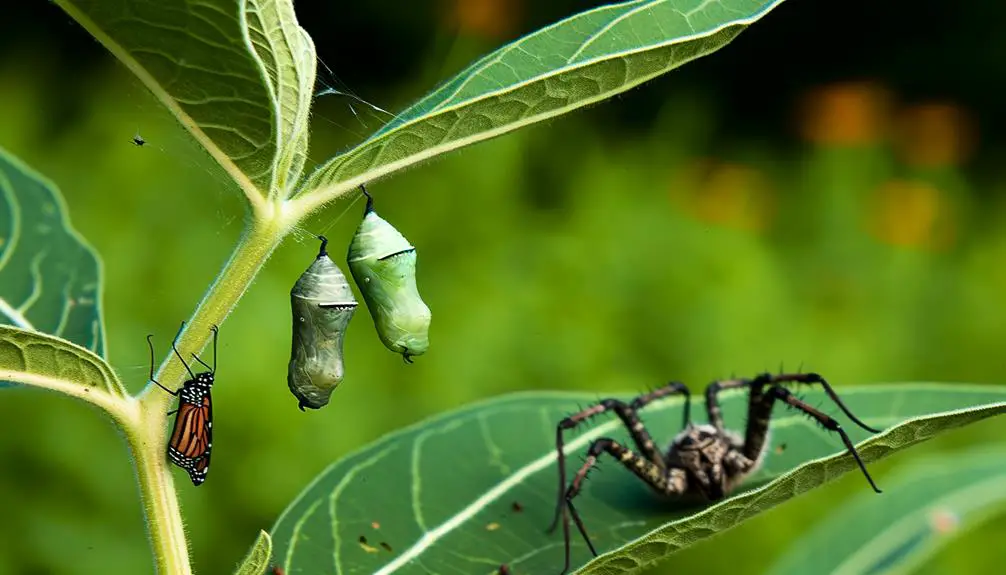
In response to predation pressures, both Queen and Monarch butterfly chrysalises exhibit distinct defensive adaptations that enhance their survival. The Queen chrysalis is characterized by its metallic gold spots, which may mimic dew droplets, thereby reducing visibility to predators. Monarch chrysalises, on the other hand, employ cryptic coloration, blending seamlessly into their surroundings.
Noteworthy defensive adaptations include:
- Aposematic coloration: Bright colors deter predators by signaling toxicity.
- Chemical defenses: Both species sequester toxic compounds from host plants, making them unpalatable.
- Camouflage: The green hue of Monarch chrysalises blends with foliage, evading detection.
- Mimicry: Queen chrysalises mimic droplets of water, confusing potential threats.
These adaptations collectively enhance the chrysalises' ability to avoid predation, ensuring higher survival rates.
Geographic Distribution
Geographic distribution of Queen and Monarch butterflies exhibits significant variation, with Monarchs mainly inhabiting North America and Queens favoring tropical and subtropical regions. Monarchs are renowned for their extensive migratory patterns, traversing from Canada to central Mexico. In contrast, Queen butterflies are primarily found in the southern United States, Central America, and the Caribbean, extending into South America.
| Butterfly Species | Geographic Range |
|---|---|
| Monarch | Canada to central Mexico |
| Queen | Southern United States, Central America, Caribbean, South America |
| Monarch | Prefers temperate regions |
| Queen | Prefers warm, tropical, and subtropical climates |
This distinct distribution is driven by climatic preferences and habitat availability, influencing their respective migratory and non-migratory behaviors.
Ecological Importance
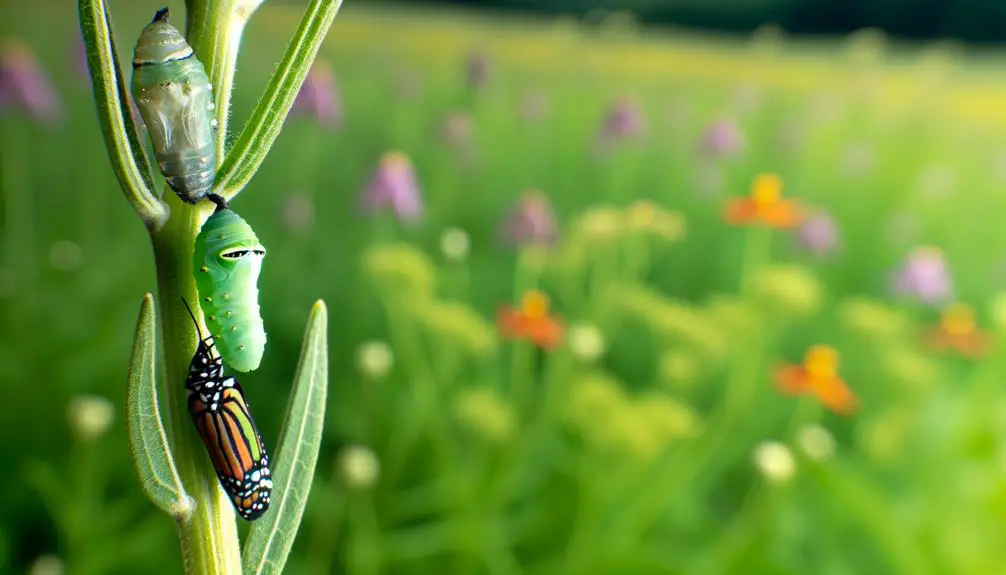
Understanding the ecological importance of Queen and Monarch butterflies requires examining how their geographic distribution influences their roles in various ecosystems.
Both species play critical roles as pollinators, contributing to the reproductive success of numerous plant species. Their migratory patterns also facilitate genetic diversity in flora across vast regions. Monarchs, with their extensive migratory routes, impact multiple ecosystems from North America to Central America.
- Pollination: Enhances agricultural productivity and biodiversity.
- Food Source: Essential for predators, maintaining trophic balance.
- Genetic Exchange: Promotes floral genetic diversity through cross-pollination.
- Indicator Species: Reflect ecosystem health, guiding conservation efforts.
Conclusion
In comparing the queen butterfly (Danaus gilippus) and the monarch butterfly (Danaus plexippus), notable differences emerge in chrysalis formation, coloration, and developmental duration.
One intriguing statistic reveals that monarch chrysalises exhibit a 15% higher survival rate due to their cryptic green coloration, which provides superior camouflage against predators.
Detailed observations and precise data underscore the ecological importance of both species and highlight their distinct strategies for survival and adaptation across different habitats and geographic distributions.

